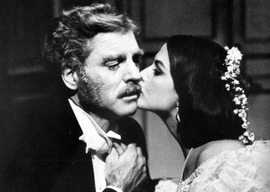
September 25, 2016

Burt Lancaster and Claudia Cardinale in The Leopard
He’s still handsome and leonine and when his nephew’s betrothed asks him to dance, the scene remains ambiguous. Does he desire her, which he certainly does, or is it simply an avuncular feeling? The strength of the story is that the physical details reveal the soul. The pomp and finery are superb, and the bon mots are as relevant today as back then: “If we want things to stay as they are, things will have to change.”
“The Sicilians think themselves perfect,” beyond improvement, thinks the prince. He tries to shock his priest, raises his eyebrows when his wife crosses herself when he appears naked in front of her, and religiously genuflects after the ball while walking home and looking at the stars. The novel ends in 1910, after the prince’s death in 1883. The Latin dismissal of women is there for everyone to see. The prince’s daughters all end up old maids, unhappy and unfulfilled, full of regrets and memories of what might have been.
Lampedusa died in 1957, and The Leopard was published posthumously. It was his only book, although there have been some short things that surfaced after that. But nothing to compare them with Il Gattopardo. His palace in Palermo had been destroyed by Allied bombs, and he had served his country in both world wars. Lung cancer killed him at sixty-one years of age.
Sicily is brown and haunting, with beautiful old houses and rubbish everywhere, violence always just around the corner, and also poetry and mournful song. The architecture is splendid, the graffiti less so. I am here to party for four days and nights without respite. I feel a bit like the prince, enjoying the present but hankering for the past.